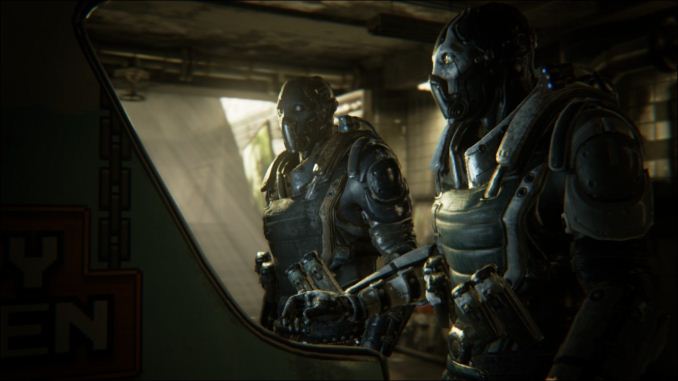Nvidia and Epic Games Showcase the Power of Tegra K1 With Unreal Engine 4 "Rivalry" Demo
by Brandon Chester on June 25, 2014 8:41 PM EST- Posted in
- NVIDIA
- Android
- Epic Games

For the past few years there have been claims that mobile graphics performance and capabilities are about to reach that of gaming consoles like the Xbox 360 and Playstation 3. Obviously because this has been going on for a few years that point hasn't quite been reached yet. But if a new tech demo from NVIDIA and Epic Games is any indication of where graphics performance is headed that goal of matching the previous generation of game consoles on a mobile device may not be far off. The below video was made in Unreal Engine 4 and rendered on NVIDIA's Tegra K1.
This tech demo was played during the keynote at Google IO. To achieve some of the effects in the video the teams at Epic Games and NVIDIA used Google's new Android Extension Pack and OpenGL ES 3.1 which are supported in the upcoming Android L release. The Android Extension Pack is a set of extensions to OpenGL ES which provides features like tessellation to improve the detail of geometry rendered onscreen, and geometry shaders which can also be used to add detail to what is rendered onscreen as well as to add shadows to a scene. The Android Extension Pack also includes support for compute shaders, and Adaptive Scalable Texture Compression (ASTC) which we've talked about in depth previously.
Of course software is just one half of the equation. The GPU in NVIDIA's Tegra K1 breaks free of the old GeForce ULP design and works with the same architecture as Nvidia's desktop GPUs. Specifically, the GPU in Tegra K1 is a Kepler based GPU with 192 CUDA cores, 4 ROPs (render output units), and 8 texture units. The 64-bit version of NVIDIA's Tegra K1 will also be one of the first chips to ship in a new wave of 64-bit Android L devices with Google having updated the OS and their ART runtime to support the ARMv8 instruction set. It will be exciting to see a new generation of games enabled by more powerful hardware like NVIDIA's Tegra K1
Source: Unreal Engine on Youtube










71 Comments
View All Comments
StevoLincolnite - Thursday, July 3, 2014 - link
I don't see how that could be a good thing.PC games are already held back by console technology, control and UI schemes, they don't need to be held back/dumbed down even more so.
Let PC games be PC games, console games be console games and mobile games be mobile games.
Krysto - Friday, June 27, 2014 - link
Nice. Hope a lot of PC games will be arriving for Android tablets and consoles now.tuxRoller - Friday, June 27, 2014 - link
Those extensions DON'T make it open gl. Whatever the sum of extensions and egles, and match that with the highest core gl profile and then you have your compatibility.I'll say again that tesselation isn't a good fit for mobile. Geometry shaders, however, will be fantastic, as will bindless textures and multi dispatch... if they actually included the later two.
lucam - Thursday, June 26, 2014 - link
Are you perhaps confusing Mantle with Metal? If so I can explain your mess around.Point is there is already a chip capable to run same engine in a different tech demo. And it's an amazing demo too.
UpSpin - Friday, June 27, 2014 - link
I'm not confusing it. It's just a typo, sorry. What I said was related to Metal. Metal is a propietary Apple only API. Of course you can port a tech demo or engine to whatever you want. And of course it will run on iOS using their propietary API. Why shouldn't it be possible?But you're completely missing the point.
lucam - Friday, June 27, 2014 - link
The point is (bloody hell) that everybody acknowledge TK1 is faster than A7, but nevertheless the latter is capable running similar demos!! U got it?So if you agree in this, u can realise this thing of Nvidia is not a miracle at all.
eddman - Thursday, June 26, 2014 - link
1. This is about hardware vs. hardware. It's pretty much known that K1's GPU is far more capable than A7's.2. How do we know that the two demos are equal in complexity?
3. There is no point in bringing APIs into this. Windows is getting DX12 and android can easily get a low-level API too. It's all software.
lucam - Friday, June 27, 2014 - link
The point is also A7 is capable to run similar things. Point is optimising the hardware you can do similar things Nvidia pretend to claim as unique. Point is I don't see the miracle rather than the usual Nvidia's claim every single year.eddman - Friday, June 27, 2014 - link
There is no magic involved in software optimization. A7's GPU is capable of 115 GFlops, K1's is capable of more than 300. No amount of optimization can close such a huge gap, unless the developers on android and windows sides are a bunch of incompetent buffoons, which I doubt is the case.Yes, A7 is powerful and can run some good looking graphics, but it definitely wouldn't be able to run them faster than a K1, again, given the programmers do it right.
Krysto - Friday, June 27, 2014 - link
The "miracle" is that PC games can be ported to Android IN WEEKS, without special low-level hardware optimizations that only work with some devices, and most likely working better, too, since Tegra K1 GPU is much faster than A7's GPU.